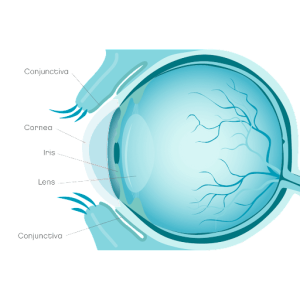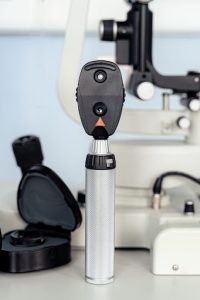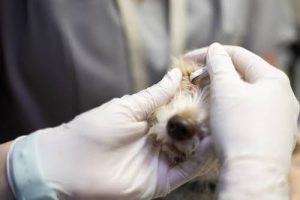Dry eye is a very common eye condition in dogs. It affects around 1 in 250 dogs (0.4% of the population). Dogs of any breed, age or sex can get dry eye. But it’s most likely in certain breeds and after taking some types of medicine.
Vets call dry-eye Keratoconjunctivitis sicca or simply KCS. It means your dog can’t produce enough tears to keep the surface of their eye healthy. Dogs with dry eye are prone to sticky discharge, conjunctivitis and painful eye ulcers. There’s rarely a cure for dry-eye, but the condition can be effectively controlled with drops or surgery. Early identification offers the best chance of successfully managing dry eye and minimising long-term damage to the eye surface.
Overview
What is dry eye in dogs?
Tears are produced by glands in the conjunctiva and the third eyelid (in the corner of the eye). They’re swept across the eye when your dog blinks.
The role of tears:
- Moisturising and cleansing the clear surface of the eye (the cornea)
- Protecting the eyes from dirt, dust or other debris
- Maintaining eye comfort

Dry eye happens when the tear-producing glands become unable to produce enough tears to keep the cornea moist. The cornea becomes dry, irritated and painful. And failure to wash away things like dust results in even more damage.
Causes of dry eye
- Immune diseases: the body’s defence cells attack and destroy the tear-producing glands by mistake
- Certain systemic illnesses: hypothyroidism, canine distemper
- Certain medications: sulphonamide antibiotics
- Idiopathic dry eye: a nerve condition where just one eye is affected, and the nostril on the same side is also dry
- Damage to the facial nerve due to severe chronic ear disease
- Removal of the third eyelid gland as a treatment for cherry eye
Symptoms
What are the symptoms of dry eye in dogs?
Dry eye may affect one or both eyes, depending on the cause.
Symptoms include:
- Red painful looking eye(s)
- A thick sticky grey/green discharge on the surface of the eye and in the corner. Especially in the morning.
- Squinting or reluctance to open the affected eye(s)
- A dull, rough appearance to the cornea
- Spidery red blood vessels on the surface of the eye
- Scarring or dark pigment on the surface of the eye, possibly reducing vision
Symptoms develop gradually as inflammation and eye damage worsen. The dry, inflamed cornea is also likely to develop conjunctivitis and painful corneal ulcers.
Risk
Which dogs are most at risk of dry eye?
Any dog can develop dry eye, but certain factors increase the risk:
- Belonging to certain breeds: West Highland White Terriers, Cocker spaniels, Cavalier King Charles Spaniels, Lhasa Apsos and Shih Tzu. As well as English Bulldogs, English Bull Terriers, Chihuahuas, Dachshunds and Pekinese.
- Having another illness: hypothyroidism, canine distemper
- Getting certain medicines: sulphonamide antibiotics. May cause temporary or permanent dry eye.
- Dogs who’ve had the third eyelid gland removed.
Diagnosis
How do vets diagnose dry eye in dogs?
Vets will diagnose dry eye based on the history of sticky discharge and inflamed eyes and on the following tests:
- Ophthalmoscope exam: checking the surface and deeper structures of the eye.

- Schirmer tear test: A simple painless test to find out how much moisture (tears) your dog produces in 1 minute. The test involves touching a slim piece of specialised filter paper to the eye surface. Dogs with dry eye produce little, if any, moisture, so the paper stays dry.

Vet treatment
Vet treatment for dry eye in dogs
Special eye drops:
- Lubricants or tear replacements: Provide extra moisture to keep the eye comfortable and protected. Especially important overnight, when your dog is asleep and blinks less.
- Immunosuppressive drops: Cyclosporine drops and Tacrolimus drops – combat damage by the body’s defence cells.
- A nerve stimulant, Pilocarpine: an effective treatment for dry eye due to nerve damage.
Surgery:
- Parotid duct transposition: Replacing tears with saliva. An operation to move one of the ducts (tubes) carrying saliva from a salivary gland to the eye instead of the mouth. This keeps the eye moist and comfortable but very wet. Drawbacks include skin irritation, dermatitis and calcium in saliva can irritate the eye.
- Medial canthoplasty: Reducing the space between the eyelids by removing some of the eyelid in the corner next to the nose. Helps to prevent tears from running off the face. Particularly helpful for dogs with very short faces (brachycephalics). Makes blinking more effective. Tears are carried across the whole cornea.
Home treatment
How to care for a dog with dry eye at home
There are no home remedies for dry eye. But ongoing home care is essential to keep your dog’s eyes as clean and comfortable as possible.
- Use all medicines at the time and dose prescribed
- Bathe gently with cooled, boiled drinking water and a clean cotton pad. Do this twice daily to remove any sticky discharge that accumulates.
- Avoid walks in dry dusty places or in windy weather
- Monitor carefully for signs of discomfort, such as holding the eye closed, increased rubbing, and redness
Prevention
Can dry eye in dogs be prevented?
In most cases, getting KCS is an unfortunate chance and can’t be prevented.
For the more preventable causes:
- Prompt recognition and treatment of illnesses that predispose to dry eye.
- Careful monitoring of tear production in dogs receiving medicine that may trigger dry eye.
- Avoiding medication likely to trigger dry eye in susceptible breeds.
When to worry
When to worry about dry eye in dogs
Contact a vet as soon as possible if:
- Your dog seems suddenly blind.
- They are unable to open their eye(s) and are in pain.
- A new white or pink patch appears on the surface of the eye (an ulcer).
Joii can help with:
- Assessing discharges or weepy eyes.
- Simple eye treatments.
- How to apply eye drops in dogs.
- Recognising pain in dogs.








